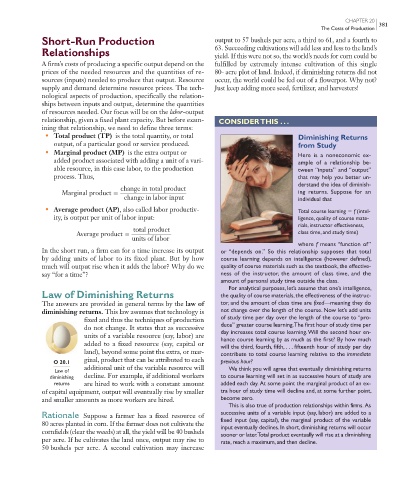Page 449 - Economics
P. 449
CONFIRMING PAGES
CHAPTER 20
381
The Costs of Production
Short-Run Production output to 57 bushels per acre, a third to 61, and a fourth to
Relationships 63. Succeeding cultivations will add less and less to the land’s
yield. If this were not so, the world’s needs for corn could be
A firm’s costs of producing a specific output depend on the fulfilled by extremely intense cultivation of this single
prices of the needed resources and the quantities of re- 80- acre plot of land. Indeed, if diminishing returns did not
sources (inputs) needed to produce that output. Resource occur, the world could be fed out of a flowerpot. Why not?
supply and demand determine resource prices. The tech- Just keep adding more seed, fertilizer, and harvesters!
nological aspects of production, specifically the relation-
ships between inputs and output, determine the quantities
of resources needed. Our focus will be on the labor-output
relationship, given a fixed plant capacity. But before exam- CONSIDER THIS . . .
ining that relationship, we need to define three terms:
• Total product (TP) is the total quantity, or total Diminishing Returns
output, of a particular good or service produced. from Study
• Marginal product (MP) is the extra output or Here is a noneconomic ex-
added product associated with adding a unit of a vari- ample of a relationship be-
able resource, in this case labor, to the production tween “inputs” and “output”
process. Thus, that may help you better un-
derstand the idea of diminish-
change in total product
Marginal product ____________________ ing returns. Suppose for an
change in labor input individual that
• Average product (AP), also called labor productiv- Total course learning f (intel-
ity, is output per unit of labor input: ligence, quality of course mate-
rials, instructor effectiveness,
total product
Average product ____________ class time, and study time)
units of labor
where f means “function of”
In the short run, a firm can for a time increase its output or “depends on.” So this relationship supposes that total
by adding units of labor to its fixed plant. But by how course learning depends on intelligence (however defined),
much will output rise when it adds the labor? Why do we quality of course materials such as the textbook, the effective-
say “for a time”? ness of the instructor, the amount of class time, and the
amount of personal study time outside the class.
For analytical purposes, let’s assume that one’s intelligence,
Law of Diminishing Returns the quality of course materials, the effectiveness of the instruc-
The answers are provided in general terms by the law of tor, and the amount of class time are fixed—meaning they do
diminishing returns. This law assumes that technology is not change over the length of the course. Now let’s add units
fixed and thus the techniques of production of study time per day over the length of the course to “pro-
do not change. It states that as successive duce” greater course learning. The first hour of study time per
units of a variable resource (say, labor) are day increases total course learning. Will the second hour en-
hance course learning by as much as the first? By how much
added to a fixed resource (say, capital or will the third, fourth, fifth, . . . fifteenth hour of study per day
land), beyond some point the extra, or mar- contribute to total course learning relative to the immediate
ginal, product that can be attributed to each
O 20.1 previous hour?
additional unit of the variable resource will We think you will agree that eventually diminishing returns
Law of
diminishing decline. For example, if additional workers to course learning will set in as successive hours of study are
returns are hired to work with a constant amount added each day. At some point the marginal product of an ex-
of capital equipment, output will eventually rise by smaller tra hour of study time will decline and, at some further point,
and smaller amounts as more workers are hired. become zero.
This is also true of production relationships within firms. As
successive units of a variable input (say, labor) are added to a
Rationale Suppose a farmer has a fixed resource of
80 acres planted in corn. If the farmer does not cultivate the fixed input (say, capital), the marginal product of the variable
input eventually declines. In short, diminishing returns will occur
cornfields (clear the weeds) at all, the yield will be 40 bushels sooner or later. Total product eventually will rise at a diminishing
per acre. If he cultivates the land once, output may rise to rate, reach a maximum, and then decline.
50 bushels per acre. A second cultivation may increase
mcc26632_ch20_378-398.indd 381 9/7/06 3:42:25 PM
9/7/06 3:42:25 PM
mcc26632_ch20_378-398.indd 381

